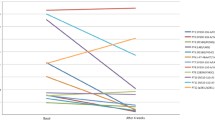Summary
In phenylketonuria (PKU), compliance with taking protein substitute is an issue in teenage and older patients. A ‘ready to drink’ protein substitute may overcome many of the practical issues associated with its administration. Objective To investigate the efficacy of a liquid protein substitute in a 6-week, three-part, randomized, crossover, controlled study. Methods 27 subjects (15 female; 12 male) with PKU with a median age of 30 years (range 8–49 years) were recruited. One subject withdrew from the study. Their median daily dose of protein equivalent was 60 g (range 45--75 g). In parts 1 and 2, subjects were randomized to either a liquid or a powder protein substitute with the same nutritional composition per unit (each 130 ml liquid pouch or 25 g powder sachet contained 15 g protein equivalent). In part 3, subjects chose liquid, powder or a combination of both. Weekly blood phenylalanine (Phe) concentrations were estimated, and during weeks 2, 4 and 6 subjects completed a daily questionnaire on administration issues. Results All but one of 26 subjects chose the liquid in part 3 as either their sole (69%, n = 18) or partial source (28%, n = 7) of protein substitute. Blood Phe concentrations were significantly better on the liquid (p = 0.03). With the liquid protein substitute, subjects were less self-consciousness (p = 0.003) and found it easier to take away from home (p = 0.001). Overall, the liquid was easier (p < 0.0001), more convenient (p = 0.002) and resulted in less wastage of protein substitute (p = 0.001). Conclusion Liquid protein substitute was popular and efficacious, reduced self-consciousness and overall improved compliance of teenagers and adults with PKU.
Similar content being viewed by others
Abbreviations
- Phe:
-
phenylalanine
- PKU:
-
phenylketonuria
References
MacDonald A, Ferguson C, Rylance G, et al (2003) Are tablets a practical source of protein substitute in phenylketonuria? Arch Dis Child 88:327–329.
MacDonald A, Lilburn M, Cochrane B, et al (2004) A new, low-volume protein substitute for teenagers and adults with phenylketonuria. J Inherit Metab Dis 27:127–135.
Mundy H, Lilburn M, Cousins A., Lee P (2002) Dietary control of phenylketonuria. Lancet 360(Dec 21):2076.
National Institutes of Health Consensus Development Conference Statement: Phenylketonuria: Screening and Management (2001) Pediatrics 108:972–982.
Report of Medical Research Council Working Party on Phenylketonuria (1993) Recommendations on the dietary management of phenylketonuria. Arch Dis Child 68:426–427.
Walter JH, White FJ (2004) Blood phenylalanine control in adolescents with phenylketonuria. Int J Adolesc Med Health 16:41–45.
Walter JH, White FJ, Hall SK, et al (2002). How practical are recommendations for dietary control in phenylketonuria? Lancet 360 (July 6):55–57.
Author information
Authors and Affiliations
Corresponding author
Additional information
Communicating Editor: Guy Besley
Competing interests: None declared
Rights and permissions
About this article
Cite this article
MacDonald, A., Lilburn M, M., Davies, P. et al. ‘Ready to drink’ protein substitute is easier is for people with phenylketonuria. J Inherit Metab Dis 29, 526–531 (2006). https://doi.org/10.1007/s10545-006-0234-y
Received:
Accepted:
Published:
Issue Date:
DOI: https://doi.org/10.1007/s10545-006-0234-y



